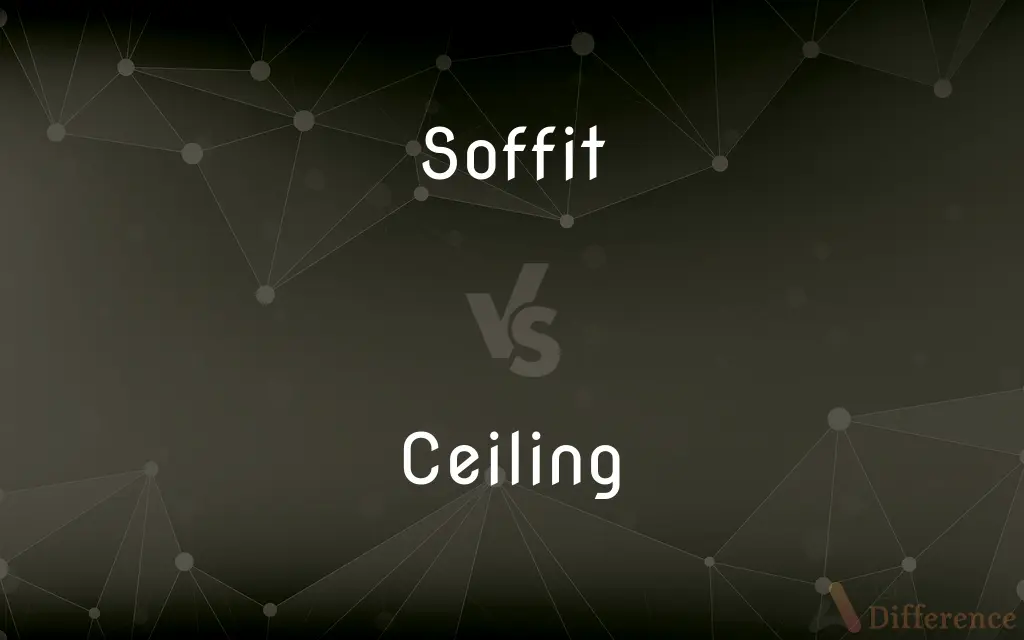Soffit vs. Ceiling — What's the Difference?
Edited by Tayyaba Rehman — By Maham Liaqat — Updated on March 18, 2024
Soffits are the underside of architectural features, often exterior, providing ventilation and aesthetics, whereas ceilings are the upper interior surface of rooms, crucial for acoustic and thermal insulation.

Difference Between Soffit and Ceiling
Table of Contents
ADVERTISEMENT
Key Differences
Soffits are typically found on the exterior of buildings, covering the underside of architectural features like roofs or overhangs. They play a crucial role in ventilation and can also contribute to the aesthetics of a building. Ceilings, on the other hand, are the upper interior surfaces of rooms, serving both practical purposes like acoustic and thermal insulation and aesthetic purposes.
While soffits are mainly used in exterior applications to protect rafters from the elements and to disguise ventilation for attic spaces, ceilings are an integral part of interior design. They can be constructed from a variety of materials and may include decorative elements, lighting fixtures, and utilities like plumbing and wiring.
Soffits can also be found in interior applications, such as the underside of a staircase or a projecting balcony. However, their primary function remains the same: to conceal structural elements or utilities. In contrast, ceilings define the look and feel of a room's interior, with options ranging from simple plaster finishes to intricate designs and materials.
The construction and materials of soffits vary widely, from aluminum and vinyl for exterior soffits to wood and drywall for interiors. These materials are chosen for their durability, ease of maintenance, and appearance. Ceilings also offer a wide range of material choices but focus more on aesthetics, acoustic properties, and the ability to integrate with the building's heating and cooling systems.
Soffits and ceilings play different roles in a building's design and functionality. While soffits are primarily concerned with protection and ventilation, ceilings focus on creating a comfortable and visually pleasing interior environment.
ADVERTISEMENT
Comparison Chart
Location
Typically exterior, under architectural features like roofs
Interior, upper surface of rooms
Primary Function
Ventilation, protection, concealment of structural elements
Acoustic and thermal insulation, aesthetic appeal
Materials
Aluminum, vinyl, wood, drywall (for interior soffits)
Plaster, drywall, wood, tiles, various decorative materials
Aesthetic Role
Contributes to exterior aesthetics, often matching siding
Central to interior design, with options for intricate designs
Installation Context
Used in both exterior (more common) and interior settings
Exclusively interior
Compare with Definitions
Soffit
A material used to enclose and protect the underside of an architectural feature.
Vinyl soffit panels were chosen for their durability and low maintenance.
Ceiling
The upper interior surface of a room or space.
The ceiling was painted a light blue to give the room a more open feel.
Soffit
Interior soffits can be used to house lighting or conceal plumbing.
The kitchen soffit concealed the ductwork above the cabinets.
Ceiling
Integral to a room's acoustic design, affecting sound quality.
Acoustic tiles were used in the ceiling to enhance sound absorption in the auditorium.
Soffit
Essential for preventing moisture buildup in attics and eaves.
Properly vented soffit panels help prevent roof rot by allowing air circulation.
Ceiling
Can be designed to hide utilities or structural components.
The false ceiling was installed to conceal the building's wiring and plumbing.
Soffit
The underside of an architectural structure, such as a roof overhang.
The soffit was installed to ensure proper attic ventilation.
Ceiling
A surface that can feature decorative elements, such as moldings or frescoes.
The historic building featured ceilings with intricate plasterwork.
Soffit
A soffit is an exterior or interior architectural feature, generally the horizontal, aloft underside of any construction element. Its archetypal form, sometimes incorporating or implying the projection of beams, is the underside of eaves (to connect a retaining wall to projecting edge(s) of the roof).
Ceiling
A ceiling is an overhead interior surface that covers the upper limits of a room. It is not generally considered a structural element, but a finished surface concealing the underside of the roof structure or the floor of a story above.
Soffit
Part of the exterior building design that provides aesthetic continuity.
The home's soffit matched its siding for a cohesive look.
Ceiling
Affects the thermal comfort of a space by providing insulation.
Insulated ceiling panels helped reduce heating costs during the winter.
Soffit
The underside of an architectural structure such as an arch, a balcony, or overhanging eaves.
Ceiling
The upper interior surface of a room or other similar compartment
The books were stacked from floor to ceiling
Soffit
The underside of a structural component, such as a beam, arch, staircase, or cornice.
Ceiling
The inside planking of a ship's bottom and sides.
Soffit
(architectural element) The visible underside of an arch, balcony, beam, cornice, staircase, vault or any other architectural element.
Ceiling
The upper interior surface of a room.
Soffit
(pipe technology) The top point of the inside open section of a pipe or box conduit.
The elevation of the pipe soffit is 10.4 meters above mean sea level.
Ceiling
Material used to cover this surface.
Soffit
The under side of the subordinate parts and members of buildings, such as staircases, entablatures, archways, cornices, or the like. See Illust. of Lintel.
Ceiling
Something resembling a ceiling
A ceiling of leaves over the arbor.
Soffit
The underside of a part of a building (such as an arch or overhang or beam etc.)
Ceiling
An upper limit, especially as set by regulation
Wage and price ceilings.
Ceiling
The highest altitude under particular weather conditions from which the ground is still visible.
Ceiling
The altitude of the lowest layer of clouds.
Ceiling
The maximum altitude that an aircraft can reach under a given set of conditions, such as a minimum rate of climb.
Ceiling
(Nautical) The planking applied to the interior framework of a ship.
Ceiling
The overhead closure of a room.
The dining room had an ornate ceiling.
Ceiling
The upper limit of an object or action.
Ceiling
(aviation) The highest altitude at which an aircraft can safely maintain flight.
Ceiling
(meteorology) The measurement of visible distance from ground or sea level to an overcast cloud cover; under a clear sky, the ceiling measurement is identified as "unlimited."
Even though it was cloudy, there was still enough ceiling for the Blue Angels to perform a great show.
Ceiling
(mathematics) The smallest integer greater than or equal to a given number.
The ceiling of 4.5 is 5; the ceiling of −4.5 is −4.
Ceiling
(nautical) The inner planking of a vessel.
Ceiling
(finance) The maximum permitted level in a financial transaction.
Ceiling
(architecture) The overhead interior surface that covers the upper limits of a room.
Ceiling
The inside lining of a room overhead; the under side of the floor above; the upper surface opposite to the floor.
Ceiling
The inner planking of a vessel.
Ceiling
The overhead upper surface of a room;
He hated painting the ceiling
Ceiling
(meteorology) altitude of the lowest layer of clouds
Ceiling
An upper limit on what is allowed;
They established a cap for prices
Ceiling
Maximum altitude at which a plane can fly (under specified conditions)
Common Curiosities
How do ceilings contribute to a room's acoustics?
Ceilings can enhance a room's sound quality through materials and designs that absorb or reflect sound appropriately.
What materials are commonly used for soffits?
Materials include aluminum, vinyl, wood, and drywall, chosen for their durability and maintenance ease.
How do soffits impact a building's ventilation?
Soffits play a key role in attic and building ventilation, preventing moisture buildup and temperature extremes.
What is the main purpose of a soffit?
To provide ventilation, protect the underside of architectural features, and conceal structural elements or utilities.
Are soffits necessary for all buildings?
While not all buildings have soffits, they are crucial for those with roof overhangs or features requiring ventilation and protection.
Can soffits be used indoors?
Yes, interior soffits are used to conceal structural elements, utilities, or for aesthetic purposes.
Can a ceiling have no decorative elements?
Yes, ceilings can be simple and functional without decorative elements, especially in utilitarian spaces.
What factors influence the choice of ceiling materials?
Factors include aesthetic goals, acoustic requirements, and the need for insulation or integration with building systems.
Can ceilings be part of the building's exterior?
No, ceilings are specifically the upper interior surfaces of rooms, though some outdoor structures may have ceiling-like features under covered areas.
What is the aesthetic role of ceilings in interior design?
Ceilings significantly impact a room's aesthetic appeal, with the potential for intricate designs, lighting fixtures, and colors.
Share Your Discovery

Previous Comparison
Poplar vs. Aspen
Next Comparison
Needs vs. NecessitateAuthor Spotlight
Written by
Maham LiaqatEdited by
Tayyaba RehmanTayyaba Rehman is a distinguished writer, currently serving as a primary contributor to askdifference.com. As a researcher in semantics and etymology, Tayyaba's passion for the complexity of languages and their distinctions has found a perfect home on the platform. Tayyaba delves into the intricacies of language, distinguishing between commonly confused words and phrases, thereby providing clarity for readers worldwide.















































